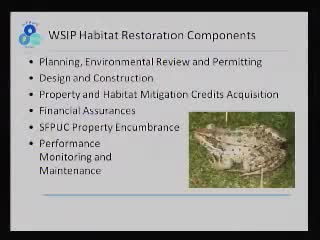San Francisco PUC funds $931K for Middle Bear Island habitat restoration with Ducks Unlimited
October 26, 2010 | San Francisco City, San Francisco County, California
This article was created by AI summarizing key points discussed. AI makes mistakes, so for full details and context, please refer to the video of the full meeting. Please report any errors so we can fix them. Report an error »

In a recent meeting held by the San Francisco Public Utilities Commission (PUC), officials outlined a comprehensive plan for habitat restoration as part of the Water System Improvement Program (WSIP). The proposed approach emphasizes a consolidated strategy that integrates various project components, including planning, environmental review, permitting, design, and construction, aimed at enhancing local ecosystems while meeting regulatory requirements.
The PUC's habitat restoration plan is projected to cost $54 million, which includes an $8 million deposit into a special account for future capital replacement projects. This financial strategy is designed to ensure long-term monitoring and maintenance of restored habitats, with the bulk of construction scheduled for February 2026. The plan also involves acquiring habitat credits and property interests, which are essential for fulfilling legal obligations related to environmental mitigation.
A significant aspect of the discussion revolved around the necessity of financial assurances and property encumbrances, which are mandated by law. The PUC has proposed to fund annual monitoring and maintenance through ongoing budget appropriations, ensuring that the ecological integrity of the restoration sites is upheld over time. The commission is preparing to approve multiple contracts for the construction of 20 different habitat sites, reflecting the diverse needs of various ecosystems.
Public comments during the meeting highlighted both support and concerns regarding the restoration strategy. Jeff Miller from the Alameda Creek Alliance expressed support for the consolidated approach but raised questions about the appropriateness of using existing public lands for mitigation purposes. He argued that these lands, already owned by the PUC, should not be counted as new habitat creation since they are not at risk of development. Instead, he suggested that mitigation efforts should focus on private lands that are threatened by development.
In response, PUC officials clarified that the current strategy is compliant with resource agency requirements and is designed to mitigate the impacts of construction projects effectively. They emphasized that while enhancements on existing public lands are part of the plan, the agency is also exploring private properties for future mitigation needs.
The meeting concluded with a proposal to approve a funding agreement with Ducks Unlimited for the restoration of Middle Bear Island, a project that aims to restore 600 acres of habitat in the San Francisco Bay National Wildlife Refuge. This initiative is expected to provide significant ecological benefits, including the restoration of critical habitats for endangered species.
Overall, the discussions underscored the PUC's commitment to ecological restoration while navigating the complexities of regulatory compliance and public concerns. As the commission moves forward with its plans, the focus will remain on balancing environmental stewardship with the practicalities of urban development and infrastructure improvement.
The PUC's habitat restoration plan is projected to cost $54 million, which includes an $8 million deposit into a special account for future capital replacement projects. This financial strategy is designed to ensure long-term monitoring and maintenance of restored habitats, with the bulk of construction scheduled for February 2026. The plan also involves acquiring habitat credits and property interests, which are essential for fulfilling legal obligations related to environmental mitigation.
A significant aspect of the discussion revolved around the necessity of financial assurances and property encumbrances, which are mandated by law. The PUC has proposed to fund annual monitoring and maintenance through ongoing budget appropriations, ensuring that the ecological integrity of the restoration sites is upheld over time. The commission is preparing to approve multiple contracts for the construction of 20 different habitat sites, reflecting the diverse needs of various ecosystems.
Public comments during the meeting highlighted both support and concerns regarding the restoration strategy. Jeff Miller from the Alameda Creek Alliance expressed support for the consolidated approach but raised questions about the appropriateness of using existing public lands for mitigation purposes. He argued that these lands, already owned by the PUC, should not be counted as new habitat creation since they are not at risk of development. Instead, he suggested that mitigation efforts should focus on private lands that are threatened by development.
In response, PUC officials clarified that the current strategy is compliant with resource agency requirements and is designed to mitigate the impacts of construction projects effectively. They emphasized that while enhancements on existing public lands are part of the plan, the agency is also exploring private properties for future mitigation needs.
The meeting concluded with a proposal to approve a funding agreement with Ducks Unlimited for the restoration of Middle Bear Island, a project that aims to restore 600 acres of habitat in the San Francisco Bay National Wildlife Refuge. This initiative is expected to provide significant ecological benefits, including the restoration of critical habitats for endangered species.
Overall, the discussions underscored the PUC's commitment to ecological restoration while navigating the complexities of regulatory compliance and public concerns. As the commission moves forward with its plans, the focus will remain on balancing environmental stewardship with the practicalities of urban development and infrastructure improvement.
View full meeting
This article is based on a recent meeting—watch the full video and explore the complete transcript for deeper insights into the discussion.
View full meeting
